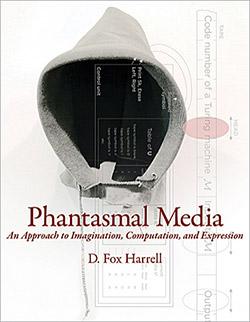
ICE Lab Director Fox Harrell has just published his newest book, Phantasmal Media: An Approach to Imagination, Computation, and Expression with the MIT Press.
In the book, Harrell considers the expressive power of computational media. Carefully grounded in computer science, cognitive science, and media studies, and using illustrative multicultural references ranging from classic cinema to science fiction, Harrell’s work has been called a manifesto on how computing can create powerful new forms of cultural expression.
The theoretical foundation for the book lies in the great expressive potential of computational media and its ability to construct and reveal what Harrell has called phantasms—blends of cultural ideas and sensory imagination. Harrell offers an approach for understanding and designing computational systems — ranging from social media and e-commerce sites to videogames and computer-based artworks — that have the power to evoke these phantasms, paying special attention to the exposure of oppressive phantasms and the creation of empowering ones. He argues for the importance of cultural content, diverse worldviews, and social values in computing. The expressive power of phantasms is not purely aesthetic, he contends; phantasmal media can express and construct the types of meaning central to the human condition.
Since it’s release, the book has received much critical acclaim coming from a variety of disciplines. For instance, U.C. Irvine professor of informatics Paul Dourish has argued that the book provides nothing less than “a new basis for understanding human-computer interaction and artificial intelligence.” Likewise, George Lewis, a professor of music at Columbia University has called it a “bold and audacious view of the relationship between computing and the imagination,” adding this “is what a groundbreaking book looks like.”
You can also read more coverage about the book in these recent press releases from the MIT News Office and the U.C. San Diego News Center.